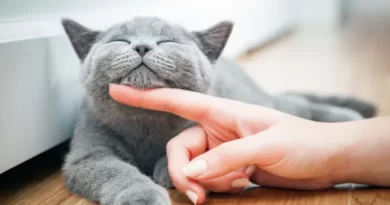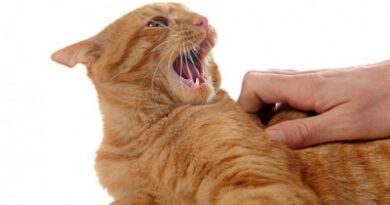What does it mean when a cat goes belly up?
What does it mean when a cat goes belly up?
If you share your home with a feline, you will know very well that there are some strange behaviors of cats that arouse great curiosity in us.
For example, many guardians wonder what it means when a cat turns on its belly and why they are often so reluctant to be petted in this region. Although we are used to interpreting this position as a request for caresses in dogs, felines hardly allow their bellies to be touched, not even by their guardians and relatives. If you’ve already tried it, maybe you’ve been surprised by a scratch or bite, right? But if they’re not asking for our cuddles, then why do cats show their bellies? And why caresses in this region can awaken aggressive behavior in our cats?

Why do cats get belly up?
To understand what it means when a cat turns on its belly, we need to better understand the postures of the cat and its meanings in the communication that it establishes with other individuals and with its environment. Unlike us, our cats mainly use their body to transmit their moods , emotions and perceptions about the world around them. Although they reveal an amazing capacity for vocalization, cats mostly use their body language to express themselves and communicate with their guardians, with other cats and with their own environment.
In general, when a cat leaves its belly exposed or sleeps on its back, it means that it experiences a moment of relaxation and well-being . Of course, a feline only adopts this posture in a safe environment and in the company of those with whom he has affection and trust. So, if your cat sleeps belly up next to you or near you, this is a sign that he feels very comfortable with your presence and that he lives in a home that gives him a sense of security and well-being.
On the other hand, if your cat sees you or welcomes you by lying down and showing his belly, it is a friendly posture to get your attention and invite you to interact or ask you for something. Your feline wants to play and share good times with you, but you should not interpret that a belly-up cat is inviting us to pet it in this region. In fact, most cats do not like to have their belly touched , as it is a very sensitive region that shelters some of their vital organs.
Eventually, your cat will also be able to roll onto his back and roll over to stretch and rub his body. It is a natural behavior that generates pleasure and relaxation. This behavior can also appear if you offer your catnip some catnip , as it acts as a powerful stimulus to his senses.
However, if you notice that your cat is lying on its back and rubbing its body very frequently or intensely, as if itching, it is important to be vigilant. Itching can appear as a symptom of allergies, external parasites or other diseases. Therefore, do not hesitate to go to the veterinary clinic with your feline when you observe that this behavior is repeated constantly and/or compulsively.
Why do cats not like belly rubs?
Unfortunately, there are many false myths about cats and it is still common for some people to wonder if cats have feelings, if they like to be petted or if they love their caregivers. But it is enough to share your home with these fascinating animals to perceive how intelligent and sensitive cats are.
That cats do not like kisses or caresses on their belly does not mean that they do not enjoy receiving pampering from their caregivers. It simply means that being touched in such a sensitive region makes them feel vulnerable and generates negative feelings such as insecurity, stress and fear . Feeling threatened, felines may adopt certain defensive behaviors to preserve their well-being, such as scratching and biting .
You have probably already heard the popular expression «defend like a cat on its back». However, it is not treacherous behavior, that is, the cat does not turn on its belly with the intention of deceiving and then attacking the other individual in a surprising way, as if taking advantage of his distraction. The truth is that a cat transmits several signals of discomfort and anger to us before adopting defensive behaviors. If your cat has its ears back, has a flattened body, closed facial expressions and its tail is taking on the shape of a brush (raised, swollen and with bristly hairs), it is communicating his anger and preparing to attack.
However, felines are perfectly capable of establishing a very special bond with their guardians, enjoying sharing good times in their company and receiving their caresses. The fact that they do not behave or express themselves like dogs or like us does not mean that they want or feel more or less. They simply express the emotions they experience and their affection for their guardians in a different way . So, instead of comparing or prejudging, let’s bet on better understanding the body language of cats and their nature to improve our communication with them.
Where can I pet my cat for him to enjoy?
In general, cats really like to be caressed on their head, chin, neck and back . However, each cat is a world and it is impossible to establish a manual on how to please, caress or pamper cats. To know where and how to pet your feline, you will have to know their tastes and identify their preferences . And this is precisely the best part of living with cats: getting to know them day by day and discovering their personality, surprising us with their abilities and learning to improve our relationship with them.
To recognize your cat’s favorite spots, start gently stroking her head and, little by little, pamper her and give her gentle massages all over her body, always paying attention to the reactions of each of your caresses. Remember to avoid sudden movements , be very careful when touching them in sensitive regions and always respect the limits of your feline. Respect is the key to establishing a healthy and positive relationship with our partners, regardless of their species.



